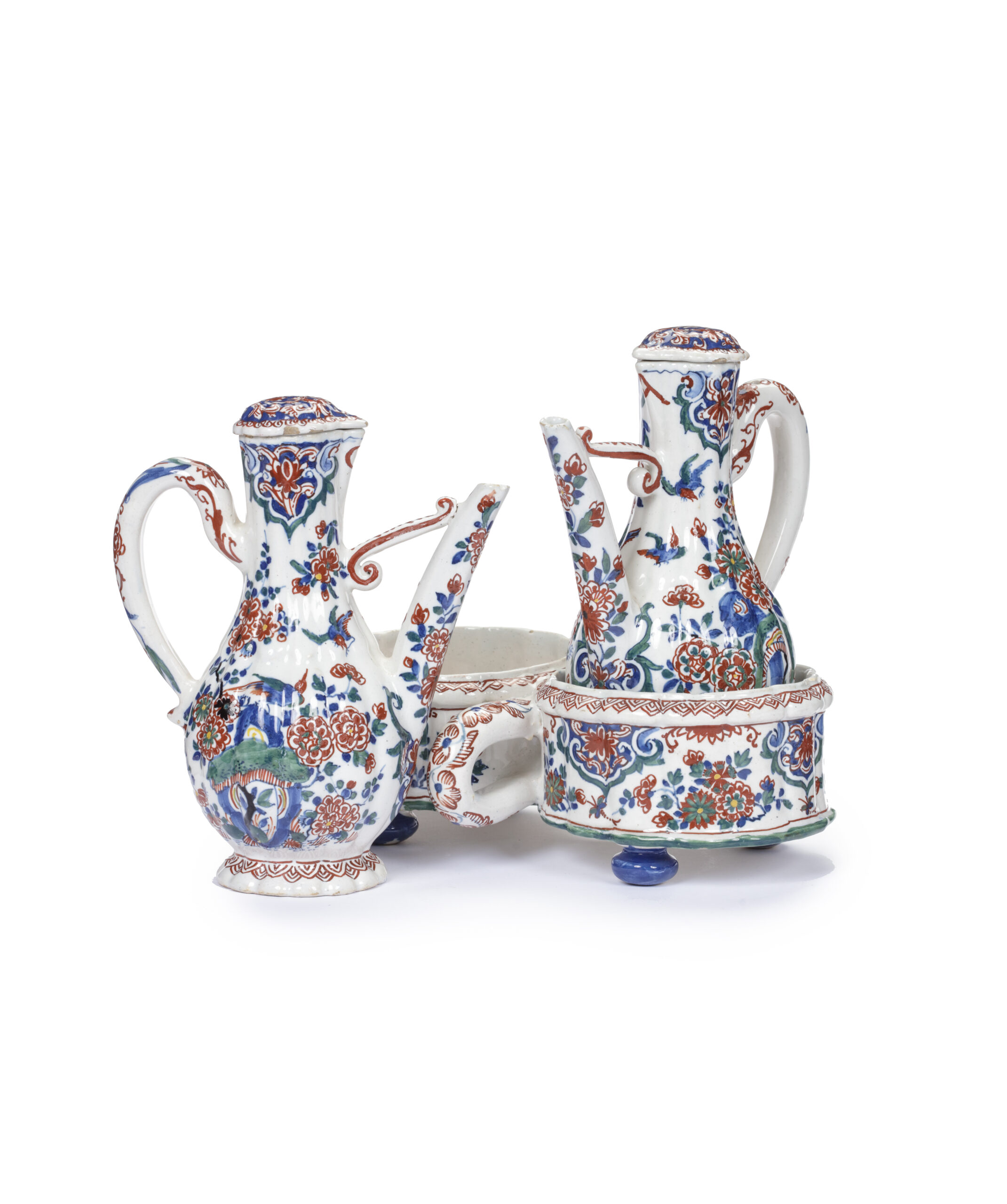[popup_trigger id=”13756″ tag=”span”]![]() [/popup_trigger]
[/popup_trigger]
Images on this website are licensed under a
Creative Commons Attribution-NoDerivs 3.0 Unported License.
OBJECT
• D2214. Polychrome Reeded Cashmere Palette Cruet Set
Delft, circa 1710
Comprising two ewers, covers and stand, all painted in the cashmere palette of blue, green, iron-red and expanded with yellow, the body of the ewers painted on one side with a bird perched on a stylized rock below a bird in flight amidst a profusion of flowers, the other side with a bird in flight above a profusion of floral plants and stylized rock work, the necks with blue ground loral lappets and the letter O or A, the spouts and loop handles with a flowering branch, the blue ground covers reserved with floral motifs; the stand with similar blue ground floral lappets alternated by lush floral sprigs and standing on blue peg feet.
DIMENSIONS
Overall height: 20.5 cm. (8.1 in.)
PROVENANCE
Aronson Antiquairs, Amsterdam 2000
LITERATURE
Described and illustrated in Aronson, Dutch Delftware, 2000, ill. 24
NOTE
A cruet is any small container with a flat-bottom, narrow neck, spout, handle, and stopper. It is used to hold liquid condiments, such as olive oil and vinegar, hence the letters O and A for the Dutch words olie and azijn, oil and vinegar. The name is believed to have derived from the Old French word crue, which means earthen pot. Others say it is from the Dutch word kruicke, which was often spelled crewet. Cruet sets like the present, consisting of an olive oil and vinegar container, could be used at meal times. They were probably a late seventeenth-century invention, when fine dining became an exceedingly important social ritual and the dinner table underwent considerable changes. Around the end of the seventeenth century, cruet sets got their usual shape that lasted well into the eighteenth century. As with many Delftware objects for the dinner table, the shape of this cruet set was probably inspired by a silver model.
Perhaps oil and vinegar were used for health reasons. People were somewhat suspicious of vegetables, since ancient health doctrine advised against the consumption of fruit and vegetables. The addition of oil and vinegar to vegetables was possibly believed to strip the food of its lesser properties. Another theory about the increased use of oil and vinegar is that the Dutch elite wanted more mild flavors in their food, and the condiments were less potent than other spices and could be used according to one’s own taste, while the original flavors of the ingredients remained more intact.
The color palette on this cruet set was given the descriptive title ‘cashmere’ for its likeness in color, and exotic, dense motifs to the fine woolen shawls that were imported from India and worn by high-class European ladies. As can be seen on the present set, the earthenware of this category has a reeded surface with a color scheme of blue, red and green, sometimes expanded with yellow or manganese. Although the Delft pieces were named after the fashionable textiles, the Delft potters were in fact inspired by the Chinese famille verte porcelain wares of the Kangxi period (1662-1722), which arrived in Europe at the end of the seventeenth century. Delftware painters also looked beyond China for further inspiration in designing cashmere pieces.
One such design source was the French baroque style that reigned during the age of King Louis XIV. Characteristic for this is the delicate use of arabesques and whimsical grotesques that originally derived from the Renaissance, and the combination of foliage with human and animal forms that prefigured the Rococo movement. Moreover, multiple garlands of flowers, draperies, scrolls, and pendants were added in order to form magnificent embroidered motifs. Since the production of these elaborate reeded pieces was probably very expensive, the cashmere palette enjoyed a brief, yet widespread success during the first half of the eighteenth century.









